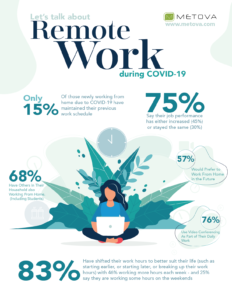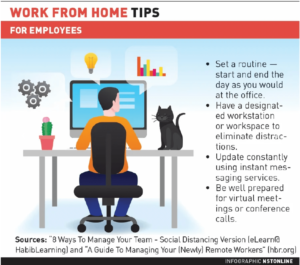Part 5- Maintaining family relations while remote working
Working from home with family present can be a big headache. How can families better cope with this?

The global response to COVID-19 has resulted in the most rapid workplace transformation. The fact is that this pandemic does not discriminate. Businesses of all sizes have been forced to adapt their business models to changing demands. The need for speed to change will not be fleeting. Much has been shared about the changes for business needs. For the month of June, we wanted to share a little about the “people side” of change. From senior to middle management, to working level employees, mental wellness and families.
At this point, the terms work-from-home(WFH) and remote working need no introduction. Most of us have been working from home for as long as we can remember, with seemingly no end in sight.
Recent studies highlight the gradual warm up of people to WFH arrangements where 80% would opt to work from home in the long term. While this may be true for the majority, transferring work into the home environment may be unsettling or even disruptive for some.
Professionals who are staying with their families, particularly those with young children, are believed to have it the hardest during this period. In the past year, there has been an increase in the number of cases relating to divorce, abuse and similar family fallouts.
Changing definitions of ‘family’ and ‘home’
Conventionally the place for rest and quality time with loved ones, home now encompasses rest and work. A shared setting blurs the line between the two, redefining family and home for some.
Balancing work & family commitments
When WFH was first introduced, families scrambled to find a way to balance out household responsibilities with work. All of a sudden, everyone was forced to co-exist in the same place consistently.
Praveen, a mother and the Head of Finance at LittleLives recalls the struggles she faced with juggling her priorities, especially during the circuit breaker period:
“[I was] unable to focus on work at all when my child is home as she demands plenty of attention and initially there [were] issues with my spouse as well working in the same environment.”
The situation pushed her to hire a domestic helper to tend to her child’s needs so she could focus on work. Additionally, working after hours became common for Praveen when she started WFH. Between spending time with family and work, she still struggles with “cutting off” from work even though WFH offers her more opportunities to bond with her family.
Truth is, finding the right balance is a learning process as we learn to cope with this novel mode of working.
Shared environment
On top of multiple responsibilities at home, the shared environment presents its own problems. Common examples include being distracted or disturbed by family members while working and the lack of a proper workspace. Such issues can lead to heightened stress and anger for family members, obstructing their productivity.
 |
Professionals such as Luke, User Experience Lead of 55 Minutes, and his wife, have given more attention to livening up their home environment while WFH:
“My wife has decorated the home with indoor plants and crafts, while I have purchased gadgets like speakers / video game systems.”
However, he still wishes for more space at home for a conducive WFH environment. He currently uses the dining table as his workspace and can hear his wife on video calls due to thin walls at home.
 |
(Source: Metova)
Connecting with family members
WFH means no daily interactions with colleagues. Instead, interactions are mostly with family members. How much conversation actually happens when everyone in the household is working? Probably little.
In a CNA commentary, June Yong states that WFH disconnects her from her family. She finds it difficult to interact with them now that the home environment is “no longer a mere space of rest and family time but also a place of vocation.” In particular, WFH has caused family members to have diverted or different focuses at any given time at home. While one may be ready to spend time with family after work, the other may still be focused on work.
On the other hand, there are situations where social interactions come at the wrong time. This is more prevalent among parents with younger children, as they seek attention or require help. While a natural part of parenting, it adds to stress and frustration of WFH parents.
Finding middle ground
With WFH to remain the norm indefinitely, it is crucial to find middle ground between family and work. Having the right balance ensures work does not come before family, strengthening familial bonds while preventing overwork. While it may seem easier said than done, here are some ways to look out for your family when WFH!
Establishing a routine
Having a routine allows you to mark out specific window periods for different activities or tasks. The routine provides, at a glance, everyone’s day so people in the household are aware and well-informed of engagements and activities. Additionally, it makes planning for (virtual) meetings or conferences easier as you’ll know when the “downtime” of your household is. For families with young children, the routine will keep them on their feet, reducing their chances of being bored or unentertained.
Adeline, a HR manager from BAR (a Potato company) adopts a daily routine for her son. It includes work, screen and play time so her son remains occupied while she works. Undoubtedly, it is difficult to get him to follow the schedule at times, but planning helps with crisis management.
Communicating with family member(s)
Communication is always key, but it is now more important than ever. Cooped up at home almost all the time now, the feeling of isolation from reduced social interaction can take a toll on the mental well-being of some. Checking in with your family members every now and then does not only provide reassurance for you, but builds their confidence in you as someone they can depend on. Not forgetting, some human interaction keeps you sane while WFH!
Having meals together is a simple and convenient way to implement these daily check-ins, set in a casual context.
Apart from daily check-ins, being in the same household all day is bound to come with occasional issues. Sharing and resolving them early help dispel potential heightened tensions and misunderstandings.
Communicating with your colleagues & bosses
Everyone is coping with the transition to WFH differently, whether it is teething problems with workspace arrangements or issues balancing between work and taking care of your child. Instead of trying to stomach everything, reach out to your colleagues and bosses for assistance. Even if nothing actionable comes out of it, at least the concerns were made known.
The role of employers
WFH gives employers the opportunity to rethink company operations, straying from the corporate setting we used to be familiar with. It’s time to get creative!
Additionally, not being in the same physical setting as employees makes it hard to see how they are coping. Here are some ways employers can ease the WFH situation for professionals:
 |
(Source: New Straits Times)
Assisting with WFH arrangements
Now that there is no longer an office for employees to report to daily, employers should ensure workers have a conducive environment. At Potato Productions, employees are rendered assistance through methods like a one-off $300 fund and an upcoming allowance for food and beverages every six months. The fund can be used for paying utilities like mobile bills and equipment for work.
Routine check-ins
To ensure all employees are coping well with WFH, employers should schedule routine check-ins with workers. These check-ins should delve into personal lives in relation to WFH and offer assistance to issues. For families with young children, check-ins can be more periodic and focus on the juggling of household duties with work responsibilities. Employers could propose more flexible work arrangements for those with young children or increased household responsibilities as a result of WFH.
Access to professional services
Employers could provide employees access to professional services like childcare and counselling for workers who need it. The funds for these services can be taken from money originally set aside for office utilities, company events etc.
Such initiatives will build trust between employer and employee, resulting in higher productivity and employee retention rate. As we know, a happy employee is a productive one!
We are only in the infancy of the WFH revolution, with it set to be the next big thing for businesses and companies. There is no better time to start listening, understanding and adapting to this new normal!
If you like our content, please reach out to us at stories@potatoproductions.com. We’re looking for content partners and we’re excited to get more eyes on interesting articles!
